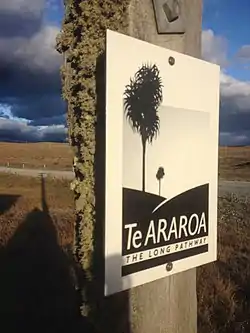Te Araroa
Te Araroa (The Long Pathway) is New Zealand's long distance tramping route, stretching circa 3,000 kilometres (1,900 mi) along the length of the country's two main islands from Cape Reinga to Bluff. It is made up of a mixture of older tracks and walkways, new tracks, and link sections alongside roads.[1] Tramping the full length of the trail generally takes three to six months.
| Te Araroa | |
|---|---|
 Te Araroa sign in front of Telegraph Hut | |
| Length | 3,000 km (1,864 mi) |
| Location | New Zealand |
| Trailheads | Cape Reinga Bluff |
| Use | Hiking |
History
The idea of a national walkway goes back to the 1970s, when it was first advocated for by the Federated Mountain Clubs of New Zealand and in 1975 the New Zealand Walkways Commission was established,[2] but in 15 years made little progress.[3] In 1994, journalist Geoff Chapple advocated a New Zealand-long walking track, and founded Te Araroa Trust.[3][4] Advocacy and negotiations for access continued, and by 2006 plans for the trail began being part of local government plans.[5] The 3,000 kilometres (1,900 mi) route officially opened on 3 December 2011 after 10 years of work by hundreds of volunteers.[6] Construction coordinated by the trust is ongoing.
The trail has approximately 300 sections ranging from walks of one to two hours through to an approximately nine-day route in the South Island where most trampers haul large amounts of food and gear. About sixty per cent of the trail crosses conservation land managed by the Department of Conservation,[7] and the Government allocated $3.8 million for development of new sections of the trail on conservation land in 2007.[8]
As of 2019 there are further plans to upgrade the trail, including a long-term goal to reduce road-walking to under 5% of the trail.[9][7]
Walking the trail
The straight-line distance from Cape Reinga to Bluff is 1,475 km (917 mi), but the Te Araroa stretches roughly 3,000 km (1,864 mi), varying in distance when sections are upgraded or otherwise changed. The trail is a mix of tracks, including wilderness tracks, paths through paddocks, beaches, roads, and highways, as well as a section which is a river and must be kayaked.[7] Many parts of the trail are challenging. In these sections, trip planning, river crossing and navigation skills are recommended, as well as a good level of fitness and heavy boots.[10]
Most through-hikers take between three and six months for a complete trip.[11] The full trail was completed in 53 days by British ultra-marathoner Jez Bragg with a dedicated support crew during the 2012–13 season.[12][13] The youngest to walk the trail was Jonathan Rapsey, who finished it at the age of 7 with his sister Elizabeth aged 9 and their parents.[14]
Hundreds of thousands of people walk some part of Te Araroa each year,[15] and in the 2018/19 summer the Te Araroa Trust counted 1200 through-walkers.[7] This was up from 550 people attempting a through-hike in 2016–17, and 350 the year before.[16] Sections of the track can see more traffic; for example, one section is seeing 70,000 to 80,000 people each year.[7] In that example, the section is on private land and has been rising, and such traffic can make using the land as a farm impractical.
With the exception of a short section of the Queen Charlotte Track at the trail's northern terminus in the South Island,[11] neither permit nor fee is required to walk Te Araroa. However, the Te Araroa Trust requests a donation of $500 per person tramping the full trail, $250 for those walking one island only, and smaller amounts for section hikers.[11] Through-hikers will also pay $92 for a six-month Department of Conservation Backcountry Hut Pass if they wish to sleep in New Zealand's extensive network of back-country huts.
Gallery
 Stirling Point, Te Araroa's southern terminus in Bluff
Stirling Point, Te Araroa's southern terminus in Bluff Te Araroa Trail sign
Te Araroa Trail sign
See also
References
- "Breast Hill track open for trampers". Otago Daily Times. 31 March 2011. Retrieved 17 February 2016.
- "New Zealand Walkways Act 1975 (1975 No 31)". Nzlii.org. Retrieved 17 February 2016.
- "Te Araroa – The Long Pathway opening | The Governor-General of New Zealand Te Kawana Tianara o Aotearoa". Gg.govt.nz. 3 December 2011. Retrieved 17 February 2016.
- "Te Araroa: Take a very long hike". The New Zealand Herald. 6 September 2001. Retrieved 17 February 2016.
- "New Zealand's Trail – Overview & History". Te Araroa. 3 December 2011. Retrieved 17 February 2016.
- "New Zealand's Trail – Home". Te Araroa. Retrieved 17 February 2016.
- "The longest walk". New Zealand Geographic. Retrieved 26 July 2019.
- "Up to 150km to be added to Te Araroa Walkway". Scoop.co.nz. 27 May 2007. Retrieved 17 February 2016.
- "Te Araroa Trust Strategic Plan 2019–2022" (PDF). Te Araroa. 2019. Retrieved 6 September 2019.
- Anderson, Charles (25 December 2015). "The first man to die on the Te Araroa Trail". Stuff.co.nz.
- "New Zealand's Trail – FAQ". Te Araroa. Retrieved 17 February 2016.
- Winner of the Ultra-Trail du Mont-Blanc in 2010
- Gale, Josh (8 February 2013). "Record run". Wildernessmag.co.nz. Archived from the original on 8 August 2014. Retrieved 23 June 2020.
- "NZ's youngest Te Araroa Trail walkers reach Bluff". Wilderness Magazine. 12 March 2019. Retrieved 26 July 2019.
- Scoullar, Dave (27 January 2019). "Conservation Comment: Te Araroa Trail concerns". ISSN 1170-0777. Retrieved 26 July 2019.
- "Record numbers take to Te Araroa, New Zealand's Trail". www.teararoa.org.nz. 15 May 2017. Retrieved 29 May 2020.
External links
| Wikivoyage has a travel guide for Te Araroa Trail. |
| Wikimedia Commons has media related to Te Araroa. |
